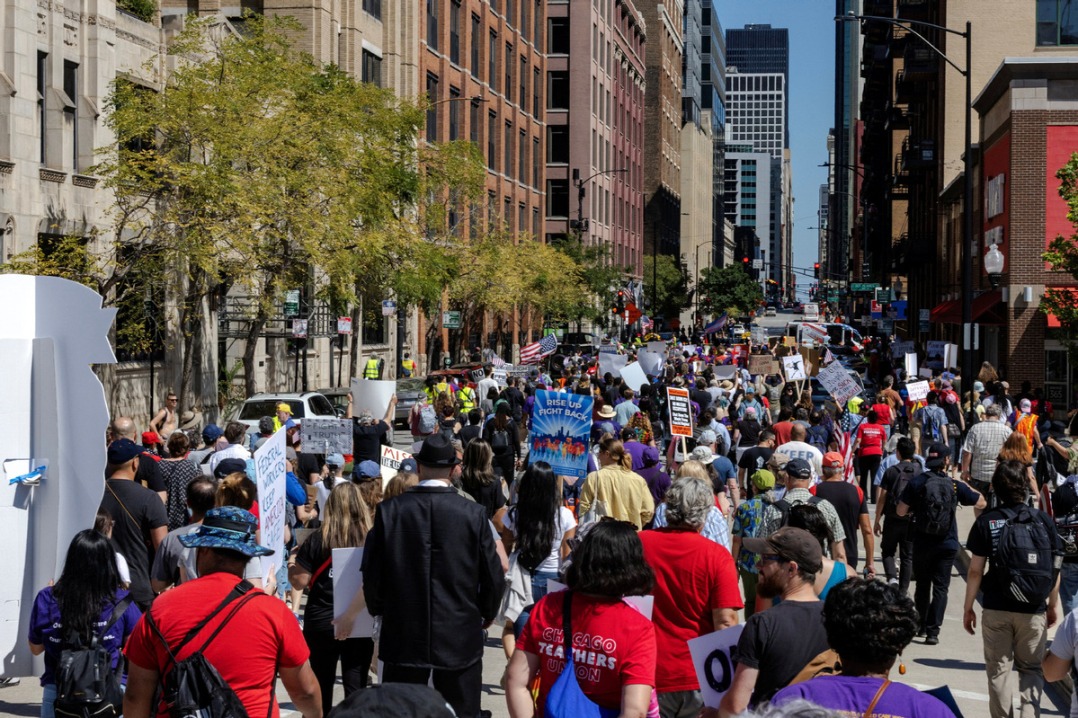US Q3 economy rebounds after sharp contraction, recovery momentum slows


WASHINGTON - US economic activity grew at a record pace in the third quarter (Q3) after a record decline amid COVID-19 shutdowns, recovering about two-thirds of the ground lost in the first half of year.
With surging cases and an uncertain prospect for more stimulus, the momentum toward recovery is slowing. Analysts believe the economy will still see contraction in 2020.
US real gross domestic product (GDP) in the third quarter expanded at an annual rate of 33.1 percent, with a quarterly growth rate of 7.4 percent, the Commerce Department reported Thursday.
Despite the seemingly fast rebound, the US Q3 economy was still down by 2.9 percent compared with that of last year, according to the advance estimate released by the department's Bureau of Economic Analysis (BEA).
BELOW PRE-PANDEMIC PEAK
Gregory Daco, the chief US economist at Oxford Economics, said on Twitter that the Q3 GDP is "record-breaking & meaningless at the same time."
Consumer spending is 3.3 percent down from the pre-pandemic level, and business investment is 4.9 percent lower, Daco noted. Exports are down by 15.3 percent and imports down by 7.1 percent.
He also noted that federal government spending is up by 2.6 percent from pre-pandemic level, while state and local government spending is down 1.9 percent.
Compared with the pre-pandemic peak in the fourth quarter of 2019, the US economy is about 3.5 percent smaller.
The rebound in the third quarter came after the economy plunged at a revised annual rate of 31.4 percent in the second quarter amid mounting COVID-19 fallout, which has been the largest decline since the US government began keeping records in 1947.
In the first quarter, the US economy shrank at an annual rate of 5 percent, signaling an end to a decade-long economic expansion following the global financial crisis.
The increase in real GDP in the third quarter reflected increases in personal consumption expenditures (PCE), private inventory investment, exports, nonresidential fixed investment, and residential fixed investment, partly offset by decreases in federal government spending and state and local government spending, the BEA report showed.
The Q3 advance was driven by a "surge" in consumer spending led by the demand for goods, and a "red-hot housing market" driven by fiscally stimulated income growth and historically low interest rates, Daco said.
Jay H. Bryson, chief economist at Wells Fargo Securities, noted that consumer spending on goods has been "significantly stronger" than spending on services because services often involve close interpersonal contact.
Although real personal spending on durable and non-durable goods have both surpassed their pre-COVID peaks, real spending on services remains 7.7 percent below its level in the fourth quarter of 2019, Bryson wrote in an analysis.
MOMENTUM IS SLOWING
Diane Swonk, chief economist at Grant Thornton, a major accounting firm, said in a blog that the bulk of the recovery in consumer spending occurred in May and June as the economy reopened.
"Momentum slowed during the summer when COVID cases and hospitalizations surged in the Sunbelt and much of the aid provided to households by the CARES Act lapsed," Swonk said, referring to the 2-trillion-dollar relief package approved by Congress in late March.
The extra 600-dollar weekly unemployment benefits from the federal government, as well as some other relief measures in the CARES Act, expired at the end of July, but Congress and the White House remain deadlocked over the next round of fiscal support.
The GDP data was released on the same day as the Labor Department reported the number of initial jobless claims in the United States fell to 751,000 last week, marking the second time the number has dipped below 800,000 in the past 32 weeks.
The total number of people claiming benefits in all programs -- state and federal combined -- for the week ending Oct 10 declined by 415,727, yet remained elevated at 22.65 million, indicating a slowing recovery in the labor market.
Economists, as well as Federal Reserve officials, have repeatedly argued that more fiscal relief is needed to sustain the economic recovery, warning of dire consequences if further fiscal support is not provided in time.
US House Speaker Nancy Pelosi and Treasury Secretary Steven Mnuchin recently held a few talks, but major differences remained. With Election Day drawing close, it is unlikely for Congress to pass any relief package before voting concludes.
"Without more stimulus, there will not be as much of a foundation to rebuild on, once the crisis passes," Swonk said.
Swonk noted that prospects for growth in the fourth quarter are deteriorating, as both consumers and businesses pull back when COVID-19 cases are surging.
The United States registered over 74,000 new cases on Wednesday, setting a new high since the onset of the pandemic in the country, according to the data of the US Centers for Disease Control and Prevention updated on Thursday.
Altogether 41 states are reporting at least 10 percent more cases compared to the week before, according to a CNN report. As daily new cases skyrocket, hospitalizations are rising, too, and deaths, which lag furthest behind those other indicators, are ticking up.
Bryson said growth in the fourth quarter is set to "slow sharply." The Wells Fargo Securities Economics Group projected that real GDP will grow at an annualized rate of 6.1 percent in the fourth quarter.
"That said, we readily acknowledge that growth in the fourth quarter may not reach that rate if some restrictions need to be re-imposed in light of the recent acceleration in COVID cases," Bryson said.

































